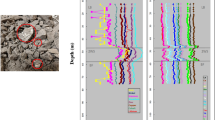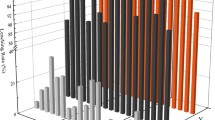Abstract
Many advanced technologies in modern society require the use of rare earth elements (REEs). Since these technologies are dominating the world, the demand for REEs is increasing fast. Therefore, finding new sources for them is highly of interest. One of the secondary sources for REEs is phosphogypsum (PG) that is a by-product generated by phosphoric acid production. This research builds upon our previous studies investigating the hydrometallurgical recovery of REEs from PG. Here, we investigate the effect of microwaving the PG sample before leaching in acid. Microwave radiation results in the dielectric heating of water molecules in the PG crystals and vaporization, causing the formation of breaks and pores in these particles as the vapor escapes. The lixivant would then be able to penetrate and diffuse further into the PG particles, bringing more REEs into solution. Our results show that REEs leaching efficiency increases when microwave treatment is used.
Access provided by CONRICYT-eBooks. Download conference paper PDF
Similar content being viewed by others
Keywords
Introduction
Rare earth elements (REEs) are a group of 17 elements including 15 lanthanides, scandium and yttrium. REEs have unique magnetic, spectroscopic, catalytic, and hydrophobic properties. Because of that they are essential for the production of many high-tech products, such as portable electronics, aeronautical components, and renewable energy. Despite their name, REEs are not rare, and even the most rare ones are 200 times more abundant than gold [1]. The problem with REEs is that they do not occur in high concentrations that are suitable for economic extractions. Also, they are mainly concentrated in a few minable resources across the world (97% in China). Also, they co-occur and their similar physicochemical properties make their individual separation and purification challenging [2].
The global demand for REEs was about 136,000 tonnes in 2013 [3] and currently it is about 200,000 tonnes (47% increase) [4]. Therefore, some of REEs are expected to be in short supply in the next 15 years [5]. Currently, 95% of the world’s production of REEs takes place in China [6]. The availability of REEs is undergoing a temporary decline mainly because of quotas imposed by the Chinese government on export and actions taken against illegal mining operations. The reduction in availability coupled with increasing demand has led to increased prices for REEs over the past few years. For those reasons, REEs have become a strategically important class of materials, and the importing countries, including Canada, United States, and European Union members have accelerated efforts to find other routes to satisfy their demands for REEs [7, 8].
Apatite, which is a mineral used for production of phosphate fertilizer, contains about 0.04–1.57 wt% REEs [9, 10]. It has been reported that 65–85% of REEs in apatite are precipitated with the process by-product, called phosphogypsum (PG) [10]. For every tonne of phosphoric acid produced, about 5 tonnes of PG is produced. Global estimated production of PG is about 100–280 million tonnes annually [11]. In most cases, it is wet stacked adjacent to fertilizer production facilities, spanning hundreds of hectares in area and a few meters in height, occupying vast amounts of land [12]. Although the concentration of REEs in PG is low, its volume is large; therefore it is a suitable secondary source for REEs.
In a recent study, we investigated the recovery of REEs from PG, obtained from the Agrium’s fertilizer production plant in Redwater, Alberta, Canada. We performed hydrometallurgical acid leaching experiments and showed that hydrochloric acid is the most efficient leachant in this process. The optimum operating conditions were determined to be 1.5 M concentration, 80 °C, solid-to-liquid ratio of 1/15, and 20 min residence time.
In the current study, we examined the effect of microwaving the PG sample before leaching in acid. Theoretically, the dielectric heating of water molecules in the PG crystals by microwave radiation would vaporize them, causing the formation of breaks and pores in these particles as the vapor escapes. The leachant would then be able to penetrate and diffuse further into the PG particles, bringing more REEs into solution. This innovative process would provide an effective and highly efficient way for recovering REEs from PG .
Results and Discussions
Phosphogypsum Characterization
Agua Regia Digestion and Inductively-Coupled Plasma (ICP-OES). The PG sample was obtained from Agrium Inc. To determine the amount of REEs present in the PG sample, we performed aqua regia digestion (Ethos EZ Microwave Digestion System) followed by Inductively-Coupled Plasma (Agilent 720-ES ICP-OES). Table 1 presents the concentration of REEs in the sample. The total content of REEs in the feed is 342 ppm. As can be seen, Y, La, Ce, Nd, and Sm have higher concentration than the rest of the REEs , so for extraction purposes, we only focused on these 5 elements.
Microwave Treatment and Leaching Experiments
To conduct microwave treatment experiments, a multi-power microwave oven (Panasonic, NN-ST775S) was used. A known amount of PG sample was placed inside an alumina crucible, which was placed inside the microwave oven for treatment. PG samples were treated at 1200 W power for 15 min. Microwave oven was purged continuously with 0.5 L/min of nitrogen gas. After each treatment, solid samples were collected and characterized by Transmission Electron Microscopy (TEM), Scanning Transmission Electron Microscopy-Energy-Dispersive X-ray Spectroscopy (STEM-EDS) (Hitachi HF-3300), Scanning Electron Microscopy (SEM) (Hitachi SU8230), and X-ray diffraction (XRD) (Philips PW1830 diffractometer). The microwave treated samples were used as the feed for the leaching experiments, using 1.5 HCl, S/L of 1/15 at 80 °C for 60 min as the leachant. Solution samples were taken using syringes and filtered by nylon syringe filters from VWR. They were then diluted and analyzed by ICP-OES (Agilent 720-ES).
Transmission Electron Microscopy (TEM), Scanning Transmission Electron Microscopy-Energy-Dispersive X-ray Spectroscopy (STEM-EDS)
To study the nature and structure of the PG sample after microwave treatment , the sample was characterized using TEM and STEM/EDS. As shown is Fig. 1b, c, this analysis confirms the presence of REEs and a cluster of Ce and La is observed in the particle.
Scanning Electron Microscopy (SEM) and X-ray Diffraction (XRD) Results
SEM analysis of as-received and microwave treated PG samples was performed to observe the morphology change of the powders due to treatment. As can be seen in Fig. 2, SEM images show that after microwave treatment , cracks and pores appear on the particles. Furthermore, XRD results indicate that the crystal structure of the particles changes. Initially there is 79% calcium sulfate dihydrate (CaSO4.2H2O) present. After 15 min treatment, there is no dihydrate left, and particle consists of hemihydrate (CaSO4.0.5H2O) and anhydrite (CaSO4) phases that have less water molecules.
Leaching Results
Leaching experiments were performed using both original PG with no treatment and microwaved PG. As can be seen in Fig. 3, microwave treatment increases the average leaching efficiency of Ce, La, Nd, Y, and Sm by 30%. The reason behind this result is that microwave radiation removes water molecules from the PG crystal (confirmed by XRD analysis, shown in Fig. 2); therefore it creates breaks and pores in these particles (shown in SEM images of Fig. 2). Therefore acid molecules can diffuse into the PG particles, extracting more REEs into solution.
Conclusions
In this research, we investigated the effect of microwave treatment on the hydrometallurgical recovery of REEs (mainly Ce, La, Nd, Sm, and Y) from phosphogypsum (PG) , which is the by-product of phosphoric acid production that is used for fertilizer applications. We obtained the PG sample from Agrium Inc. located in Alberta, Canada. Leaching experiments were performed using 1.5 M HCl at 80 °C with a solid-to-liquid ratio of 1/15. The results show that microwave treatment removes water molecules from PG crystal structure; creating cracks and pores on the particles. As a result, leachant molecules can diffuse into the particles and bring more REEs into the solution. Microwave treatment increases the average leaching efficiency of REEs by 30%. This innovative process results in a significant improvement of the recovery of REEs from PG and can potentially be implemented at large scale.
References
N.E. Topp, The chemistry of the rare earth elements, in Separating rare earth elements, ed. by D.J. Fray (New York, NY: American Elsevier Publishing Company, 1965). Science 289, 2295–2296 (2000)
M. Humphries, Rare earth elements: the global supply chain, in Congressional Research Service Report, R41347 (2013), p. 3
B. Mishra, A. Anderson, Extraction and recovery of rare-earth metals: challenges in processing. Paper presented in: ERES 2014, 1st European rare earth resources conference, Greece (2014), pp. 19–25
S. Al-Thyabat, P. Zhang, In-line extraction of REE from Dihydrate (DH) and HemiDihydrate (HDH) wet processes. Hydrometallurgy 153, 30–37 (2015)
X. Wang, Y. Lei, J. Ge, S. Wu, Production forecast of China’s rare earths based on the Generalized Weng model and policy recommendations. Resour. Policy 43, 11–18 (2015)
U.S. Department of Energy, Critical Materials Strategy (2011), pp. 113–120
Report on critical raw materials for the EU. Report of the Working Group on defining critical raw materials (2014)
B.I. Pålsson, O. Martinsson, C. Wanhainen, A. Fredriksson, Unlocking rare earth elements from European apatite-iron ores. Paper presented in: ERES2014, 1st European rare earth resources conference, Milos Island, Greece (2014), pp. 211–220
F. Habashi, The recovery of the lanthanides from phosphate rock. J. Chem. Tech. Biothechnol. 35A, 5–14 (1985)
H. Tayibi, M. Choura, F.A. López, F.J. Alguacil, A. López-Delado, Environmental impact and management of phosphogypsum. J. Environ. Manage. 90, 2377–2386 (2009)
S. Enamorado et al., Transfer of Cd, Pb, Ra and U from phosphogypsum amended soils to tomato plants. Water Air Soil Pollut. 203, 65–77 (2009)
M. Walawalkar, C. Nichol, G. Azimi, Process investigation of the acid leaching of rare earth elements from phosphogypsum using HCl, HNO3, and H2SO4. Hydrometallurgy. 166, 195–204 (2016). doi:10.1016/j.hydromet.2016.06.008
Acknowledgements
The authors would like to acknowledge the financial support provided by Agrium Inc. and Natural Sciences and Engineering Research Council of Canada (NSERC) for this project. Also, Agrium Inc. is gratefully acknowledged for providing us with phosphogypsum samples and technical support.
Author information
Authors and Affiliations
Corresponding author
Editor information
Editors and Affiliations
Rights and permissions
Copyright information
© 2017 The Minerals, Metals & Materials Society
About this paper
Cite this paper
Lambert, A., Tam, J., Azimi, G. (2017). Microwave Treatment for Extraction of Rare Earth Elements from Phosphogypsum. In: Kim, H., Alam, S., Neelameggham, N., Oosterhof, H., Ouchi, T., Guan, X. (eds) Rare Metal Technology 2017. The Minerals, Metals & Materials Series. Springer, Cham. https://doi.org/10.1007/978-3-319-51085-9_5
Download citation
DOI: https://doi.org/10.1007/978-3-319-51085-9_5
Published:
Publisher Name: Springer, Cham
Print ISBN: 978-3-319-51084-2
Online ISBN: 978-3-319-51085-9
eBook Packages: Chemistry and Materials ScienceChemistry and Material Science (R0)







